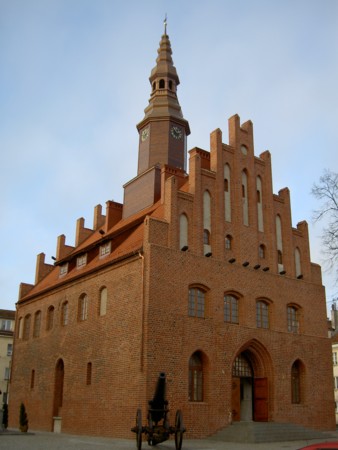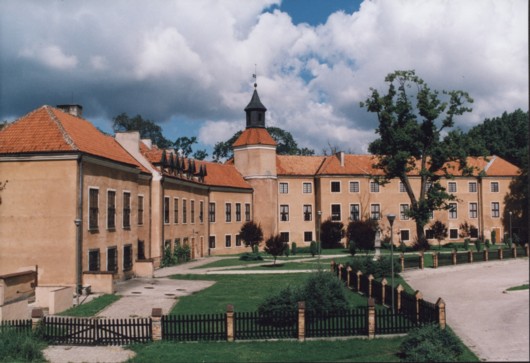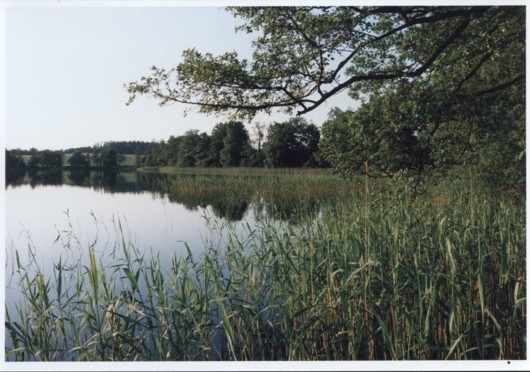Morąg

Morąg Town Hall (Photo: Tomasz Faraś, Morąg)
Distance
Population
15.000 (2003)
Location and history
Morąg is located in western Mazury, 47 km northwest of Olsztyn. Immediately east of the urban area is the small lake Skiertąg.
History: The city of Morąg was called the Mohrungen (or Morung, Moring) in German times. Around 1280, the Crusaders built a wooden fort here, which in the 1300s was replaced by a stone building. The town gained market town rights, granted by the advent of Elbląg, in 1327. In the middle of the 14th century. the city was surrounded by a wall with three gates. The city remained within the crusader state until its secularization in 1525. From that point on, the area was a secular prince (Duchy of Prussia, Polish: Prusy Książęce), which was a county under Poland. From 1701 Morąg was a member of the Kingdom of Prussia and from 1772-1945 the area was part of East Prussia which belonged to the Prussian state – later Germany. Apart from short periods when the city was in Polish hands, its history is thus linked to the Crusaders and since the Germans. In the 17th and 18th centuries. however, the Polish citizens played a significant role in Morąg and the surrounding area. Only from 1945 did Morąg really become a Polish city.
In Morąg, the philosopher and author Johann Gottfried Herder (1744-1803) was born.
Tourist attractions
City Hall . (Photo see above)
The Gothic City Hall (14th century), despite its remodeling, has retained its medieval character. Over time, the building has been destroyed several times by fires and rebuilt, the last time in 1947-48. The rectangular brick building has beautiful staircases and at the top is a small tower.
The parish church
- The Apostles Peter and Paul's Church – are listed from the beginning of the 14th to the beginning of the 16th century. It is a three-story church building with a three-sided choir. To the south is a chapel, to the north a porch. The Gothic church contains murals from the 15th century. in the choir, an impressive 13th century crucifix and altar, decorated in Baroque style. Particularly valuable is the excellent 18th-century organ, performed by Master Obuch. After the organ has been restored, the church will be held from 1997 “Summer concerts for Organ” with the participation of the best musicians.
Dohna Castle
Nobility family Dohna’s impressive castle, built 1562-71 in the Renaissance style, was rebuilt after a fire in the Baroque style in 1717-19. The building now houses a section of the Museum of Warmia and Mazury, rich collections of Dutch painting from the 17th and 18th centuries. as well as a museum for the philosopher Johann Gottfried Herder.

Dohna Castle (Pałac Dohnów) (Photo: “Photo-Ewa”, Morąg)
Bymuren
A defensive wall was erected around the city in the 14/15 year. Only a few parts of this medieval wall are preserved to this day. In the 19th century. the Ostróda Gate was demolished. Other gates in the defense facility were the Młyńska Gate and the Zamkowa Gate to the east and the Pasłęk Gate to the west. On the stretches where the wall is preserved, it is often combined with residential buildings.
Crusader fortress
The original crusader castle was erected around 1280 on a promontory on Lake Morąg’s northern shore. The castle was surrounded by a moat. In the 15th year. the castle was for a short time the seat of Grand Master Heinrich von Plauen, who died here in 1470. After secularization, the building was the seat of the princely officials as well as the Calvinist church. In the 19th century. the castle was partially demolished and rebuilt. Currently, the castle is being reconstructed, at the initiative of the private owner.
Memorial to Johann Gottfried Herder
Memorial to the German author and philosopher Johann Gottfried Herder, who was born and lived in Morąg in the years 1744-1803. Herder perceived human history as a stage in natural evolution, characterized by advances in understanding and justice. Herder is called the creator of German historical philosophy and “the father of slavery”. The first memorial was erected in 1854. The present one dates from 1964 and is a gift from the German Ministry of Culture.
During the summer holidays each year a festival is held under the name “Morąg-day” (Dni Morąga).
In addition, a number of recurring events are held in the city and the municipality, including those of a nationwide nature, e.g. The dance tournament about the Mayor of Morąg’s Cup, International Bridget Tournament “Warmiński”, Scout Song Festival, Orphanage Soccer Tournament and others.

Part of the old city wall (Photo: “Photo-Ewa”, Morąg)
Surrounding Area
Narie Lake . Naturally, Lake Narie (about 3 km east of Morąg) is the municipality's gem. The lake, which covers 1240 ha, has a very varied coastline (over 60 km long), several fjords, peninsulas and 19 small islands. The largest holiday centers on the lake are Kretowiny and Bogaczewo. Thanks to intensive efforts on the part of the municipality, Narie Lake water has maintained a first-class purity.
The wetland “Rozlewiska Morąskie” is located immediately west of the urban area. Here you can spend a lot of time observing the wealth of birds that build nests in the area. The area is a well-preserved marshland ecosystem with a wealth of animals as well as aquatic and marsh plants. The wetland covers 121.7 ha. Each year, flocks of geese, such as tundra seed (Anser fabalis rossicus), teal goose (Anser albifrons) and gray goose (Anser anser), attract. Eighteen of the bird species that build nests in this area are found on “the Polish Red Book of Animals”. These include: Pipe drum (Botaurus stellaris), small tube quail (Porzana parva), sandallo (Charadriushiatcula), beard (Panurus biarmicus), cormorant (Phalacrocorax carbo), pointed sand (Anas acuta), pipe hawk (Circus aeruginosus), small pomarina), common grouse (Calidris alpina), think tank (Tringa glareola), large rainforest (Numenius arquata), white-winged terns (Chlidonias leucopterus) and others.
Linde Island (Wyspa Lipowa) in Lake Morąg is a nature reserve, planted with ancient trees of the species small-leaved lime. Here are large colonies with cormorants and fishing herons.
Długie Lake. At this lake, southeast of Morąg, a reserve will soon be opened to protect the rare flora, including the plant black-green bream food (Isoetes lacustris).

By Lake Narie (Photo: “Photo-Ewa”, Morąg)
Accommodation
Booking.com
Morąg (Polish, English, German, Russian)
Other Internet sites and sources
Morąg (Polish, English, German, Russian)
Translated into English by Google Translate. Spangshus.dk accept no liability for any errors or omissions in translation.
Map

Rating
Search
Most used tags
churches (205) Castles (86) Monasteries (79) Town walls (74) Lakes (71) Town halls (67) Rivers (65) Castles1 (62) Mansions (55) Museums (51) Regional museums (38) Town gates (36) Abbey churches (35) Castle ruins (30) Cathedrals (26) Forests (25) Health resorts (24) Mounds (23) Water sports (23) National parks (22)Click for all tags
Denne side er også tilgængelig på dansk. This page and contents is (c) Copyright 2018- www.spangshus.dk. Based on Inviator software by ISCA Software